Menus
- Four helps a lot
- "Mileage and condition didn’t matter to me"
- 3,000 Yamaha XS 500s sold in Germany
- Chassis clearly superior to the engine
- Both copies are very rare
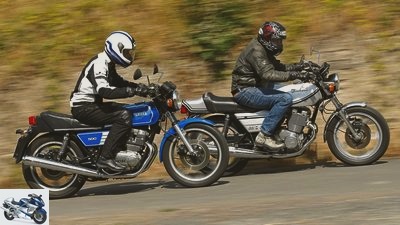
bilski-fotografie.de
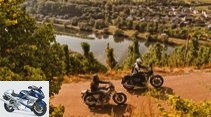
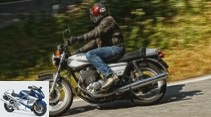
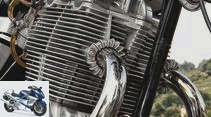
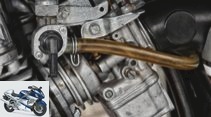
22nd photos
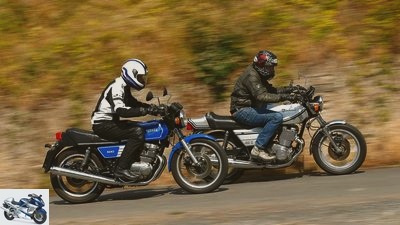
bilski-fotografie.de
1/22
Laverda 500 Alpino I Yamaha XS 500 on the move.
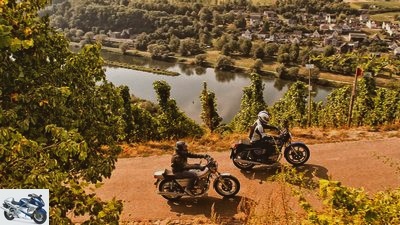
bilski-fotografie.de
2/22
Sporty Italian elegance or exotic Japanese baroque? Both four-valve twins are very rare.

bilski-fotografie.de
3/22
“With the 500 you can stroll relaxed or let it rip properly.”

bilski-fotografie.de
4/22
The Laverda twin has the massive look of the large 1000 triplets.
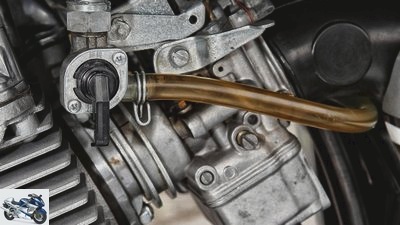
bilski-fotografie.de
5/22
The choke lever on the left 32 mm Dellorto carburetor is crouched behind the fuel tap.
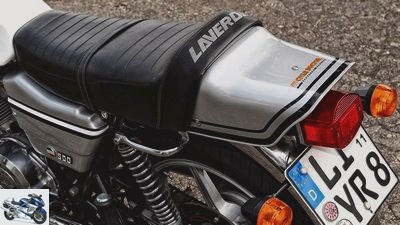
bilski-fotografie.de
6/22
Proven with the design language – the rump is reminiscent of the 3CL or Jota.
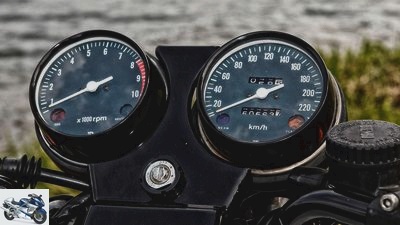
bilski-fotografie.de
7/22
In the cockpit, the Japanese standard from Nippon Denso is easy to read.
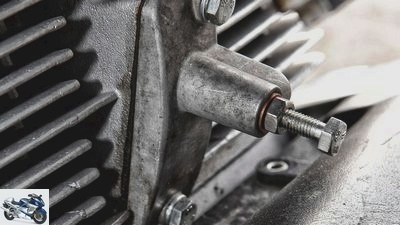
bilski-fotografie.de
8/22
The tensioner of the central timing chain is easily accessible and adjustable.
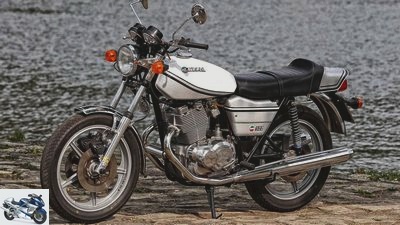
bilski-fotografie.de
9/22
Laverda 500 Alpino I Yamaha XS 500 on the move.
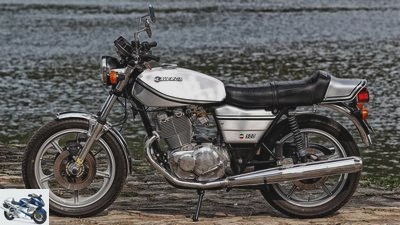
bilski-fotografie.de
10/22
Laverda 500 Alpino I Yamaha XS 500 on the move.
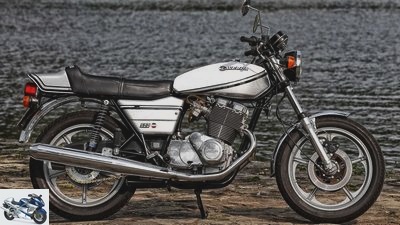
bilski-fotografie.de
11/22
Laverda 500 Alpino I Yamaha XS 500 on the move.
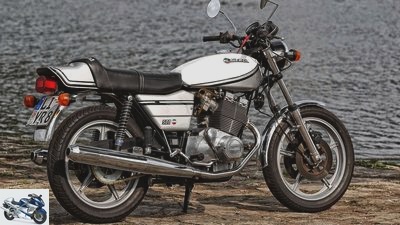
bilski-fotografie.de
12/22
Laverda 500 Alpino I Yamaha XS 500 on the move.
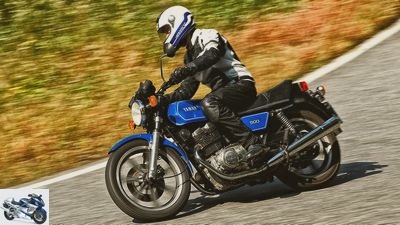
bilski-fotografie.de
13/22
All or nothing – single-stage choke knob on the Mikuni carburetor of the XS 500.
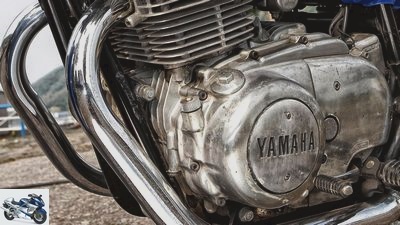
bilski-fotografie.de
14/22
Drive chains for the balance shaft and starter are at work behind the housing cover.
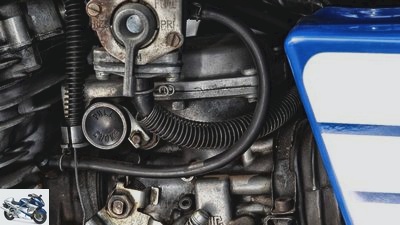
bilski-fotografie.de
15/22
Laverda 500 Alpino I Yamaha XS 500 on the move.
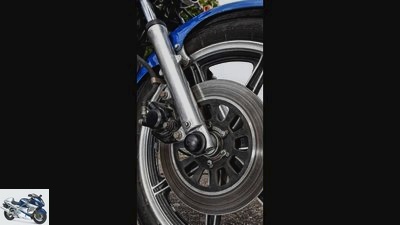
bilski-fotografie.de
16/22
Good 300 single-disc brake at the front – with a second disc for an extra charge.
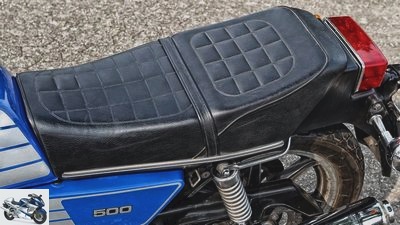
bilski-fotografie.de
17/22
Laverda 500 Alpino I Yamaha XS 500 on the move.
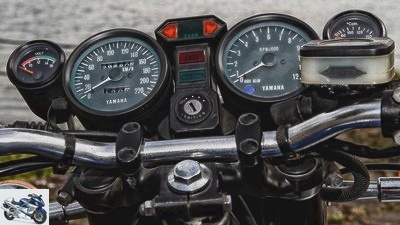
bilski-fotografie.de
18/22
Unconventionally short rear, ample seat: plenty of space for driver and front passenger.

bilski-fotografie.de
19/22
Laverda 500 Alpino I Yamaha XS 500 on the move.

bilski-fotografie.de
20/22
Laverda 500 Alpino I Yamaha XS 500 on the move.
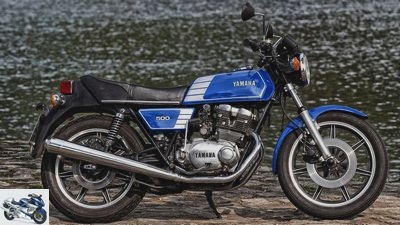
bilski-fotografie.de
21/22
Laverda 500 Alpino I Yamaha XS 500 on the move.
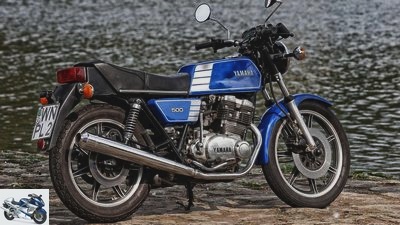
bilski-fotografie.de
22/22
Laverda 500 Alpino I Yamaha XS 500 on the move.
Laverda 500 Alpino and Yamaha XS 500
Four helps a lot
Content of
With Laverda 500 Alpino and Yamaha XS 500, four-valve technology found its way into mid-range twins in the mid-1970s. The fascination of the once progressive technology still comes across today?
Laverda began developing the 500cc twin in 1975, worked quickly and was able to present a neat half-liter bike with a modern four-valve twin at the Milan Salon that autumn. But in Italy they knew about the initial problems that YAmaha with its four-valve twin, which was introduced in 1973, didn’t and didn’t want to risk a quick shot? In any case, it was not until autumn 1977 before the Laverda could finally be bought. In Germany even until mid-1978 – the change of importer once to Louis, then Zweirad Roth, brought about the delay.
Buy complete article
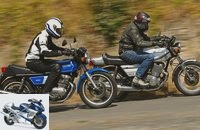
Laverda 500 Alpino and Yamaha XS 500
Four helps a lot
For 6,860 marks there was high-quality equipment
In order to be able to stand up to this Japanese woman, which was already not a record-breaking low price of 5,492 marks (1978), the Laverda had to pull up a lot for the requested 6,860 marks. The 497 cm³ engine with chain-driven overhead camshafts and four valves controlled by bucket tappets, crankshaft with four roller bearings and a counter-rotating twin with a 180 degree crank pin offset did not have to hide with 46 hp, but it was no better than the competition.
Laverda did not skimp on the add-on parts and equipment, however: a contactless Bosch transistor ignition ensures reliability, a six-speed gearbox ensures the right gear ratio at all times, and Japanese switch units and the cockpit offer good usability and display accuracy. On the other hand, a kickstarter was generously dispensed with, as it benefits from its low weight. With a full tank of 189 kilograms, the Laverda underpins its sporty aspirations, even if the soft focus on driving comfort was supposed to have priority when developing the chassis. So the first 500s rolled out of the factory in Breganze. But the first changes were already introduced in the first year after publication: So the decision was made to use a balance shaft (the first copies were still delivered without them) in order to cope with the vibrations, and the name suffix Alpina in Alpino was required early on convert – a German BMW tuner had already registered the name.
"Mileage and condition didn’t matter to me"
So today a well-maintained example of the Laverda 500 Alpino is ready for us – it belongs to Tom Eatman, Laverda enthusiast and professional screwdriver, not only, but above all, at Laverdas, domiciled in the Allgau. He owns almost all of the brand’s models; he bought his Alpino in 2006. “I didn’t care about the mileage or condition – I overhauled and renewed everything that was due anyway,” he says with the usual calm. The (relatively) new paint shines beautifully in the sun, the filigree-looking 18-inch cast wheels from Laverda’s in-house production fit perfectly with the overall picture. However, the 500er looks long-legged and more grown-up, especially in comparison to the compact, almost stocky Yamaha, even if the dimensions do not prove this. However, the weight advantage is already noticeable when sitting up and maneuvering. The choke lever sits a bit fiddly and hidden on the left carburetor, but when you press the button, the twin starts surprisingly spontaneously. The two Lafranconi pots bubble heavily, the motor grinds mechanically audibly, but above all noticeably. He doesn’t let his expressions of life take away from the balancing shaft. The clutch does not need a vice hand, and no excessive force is required to open the Dellortos.
A little speed is enough to start up, even if the Laverda-Twin does not behave as smoothly and smoothly as the XS motor. Anyone who has moved the XS 500 for a long time will feel the difference all the more clearly. Vibrations are not annoying but noticeable, and become clear with increasing engine speed and over 5,000 rpm. The engine characteristics are also clearly sportier: mobile at the bottom and in the middle, but more restrained, but with a clearer bite from 6,000 rpm, and willingly also up to the red area at 8,000 rpm.
Because the front wheel-oriented position is bent a little further over the longer tank, the Laverda 500 Alpino conveys a sporty flair and tempts you to step on the gas, despite its comfortable placement (not too wide, very well cranked handlebars, relaxed leg angles). Especially since the Marzocchi fork and the Hagon accessory struts (like the original Marzocchis) respond well and offer enough reserves to filter out rough waves. A few kilometers of curvy mountain stretch through the forest briefly let the potential flash: With such precise steering behavior and such willing folding in an inclined position, with the best stability, it is also easy to get over the fact that you now and then a few more than the 46 hp, something shorter shift travel and more precise locking of the six gears. The easy to dose, stable Brembo brakes, on the other hand, leave little to be desired. Another little extra round? What else did Tom say? “You can stroll relaxed with the 500, but also let it rip properly.” That’s right. Relaxed rolling around doesn’t get boring, but who knows how much fun brisk robbery can be, will always be tempted.
Years before the Laverda, namely in 1973, Yamaha presented a four-valve twin at the Amsterdam motorcycle fair, the TX 500. At that time, the sister TX 750 had a more rounded look and spoked wheels. And it wasn’t the first four-valve series machine either, as Honda had already presented the SL 250 S ohc stew in 1972. But the Yamaha at least produced the first series four-valve twin with two overhead camshafts. However, due to the experience with the technically sensitive TX 750, the German importer hesitated and officially did not offer the 500 in this country. America initially remained the main market for the TX 500.
Only the increasing pressure to want to offer a powerful machine in the 500 class, the visual revision (modern, angular design, fashionable cast wheels) and technical updates (Mikuni instead of the Keihin carburetor) gave the Twin, now named XS 500, a new one Chance. Presented at the Milan trade fair at the end of 1975, it was also officially offered in Germany from 1976. The only major facelift changes were made in 1977 for the 1978 model. A higher compression of 9.6 instead of 8.5: 1, a larger air filter housing and a new centrifugal governor with a different adjustment curve helped the engine to achieve a full 50 instead of the previous 48.5 hp. Larger main oil wells also ensured better thermal conditions. Work has also been done on the chassis: new cast wheels have saved a lot of weight – the front rim has been slimmed down from six to a good five, the rear from 7.15 to 6.2 kilograms. The shape of the main stand has been optimized to make it easier for the driver to jack up the XS, which still weighs 212 kilograms.
3,000 Yamaha XS 500s sold in Germany
Finding a Yamaha XS 500 for the planned comparison turned out to be no easy task. Many of the total of just under 3,000 copies sold in Germany have long been driven to shame as cheap student mopeds or are now dusty and not ready to drive in garage corners. By chance we found a machine through an advertisement that had already found a buyer, but who gave us the XS for comparison and driving shots. The seller, Wolfgang Grater, bought the XS 500 new in 1978 and was the first owner for 38 years. Without any problems with the Yamaha, as he says. The XS has not been moved much in the last few years (mostly the Harley is preferred) and should now find a new lover.
So now we have the pleasure of getting to the bottom of the fascination of the four-valve twin. The choke button is pulled, one-step, all or nothing, and after a tough turn the XS-Twin reports for duty. It takes a little patience and sensitivity to keep the engine alive until the choke can be deactivated in order to quietly listen to the bright singing and grinding. In addition to the dull bubbling from the mufflers, the running noises of the numerous chains and gears determine the soundscape. Not only are the two camshafts driven by a chain, namely by a duplex chain running in a shaft on the outside of the right cylinder, but also the balancer shaft. This is located above the crankshaft behind the cylinder base and is supposed to eliminate the last vibrations with two counterweights offset by 180 degrees. Where the twin is already designed as a counter-rotation, i.e. works with a 180 degree crank pin offset, for better mass balancing. The plain-bearing engine also runs quite smoothly, and thanks to all of the above measures, there are almost no vibrations to be felt over the entire speed range. Only the bright metallic howling increases audibly from medium speeds.
Chassis clearly superior to the engine
They are also in demand when things are going to move quickly, because one thing is quickly noticeable and was already to be suspected in view of the design features (large bore, small stroke, four small valves): The 500 is not a pulling miracle. Although the Yamaha XS 500 can be started at low speed, also thanks to the smooth, easy-to-dose clutch, and the twin pulls up cleanly and smoothly from a good 1,500 rpm, but not much happens under 3,000 tours. Only from 6,000 rpm does something like fiery propulsion appear. Revving is also his thing – the four-valve engine cheers willingly all the way to the red zone at 9,000 rpm, the precisely shiftable five-speed gearbox is appropriately stepped and always offers good connections.
The fact that the Yamaha cannot and does not want to be an athlete is not only due to the steady, unspectacular power delivery, but also to the relatively high weight. The relaxed sitting posture on the almost too wide, angular bench, in conjunction with the relaxed leg posture and the comfortably cranked handlebars, also go well with this. All in all, an inconspicuous driver’s posture that is suitable for everyday use and encourages cross-country cruising rather than heating.
Whereby the XS could. Actually. The chassis geometry with a short wheelbase and the surprisingly well-functioning spring elements allow a speedy driving style, the stability offered is always impeccable. At least that’s the memory of the previously moving Yamaha XS 500, which coincides with the praise from earlier test reports. It was not without good reason that the chassis was praised as exemplary at the time and, quite unusual for the time, it was clearly superior to the engine. Even today you can guess the nimble handling, the slight wobbly in curves and the nervous behavior of the fork are clearly due to the old tires and the slightly leaky fork. It is astonishing, however, how confidently the rear struts respond to light bumps and also withstand rough blows with ease. The now somewhat toothless brake with a muddy pressure point could probably be brought back to its old quality by bleeding. However, you can rely on the effective rear disc brake. Incidentally, the XS 500 carried the device for retrofitting a second brake disc at the front right from the start. Cost at that time: 480 marks.
Both copies are very rare
The mentioned points of criticism were also noticed by new owners Klingelhofer during the test drive. After a little cure, including new tires, the Yamaha XS 500 is now as agile as it was once praised, the XS buyer confirms today. Klingelhofer was already fascinated by the 500 when it was released, but had to be modest with the XS 360 at the time. By chance he stumbled across the ad and hit it spontaneously. He hardly has to worry about damage to the cylinder head due to overheating that often occurred at the beginning. The problems with leaking valve seats and loss of power as well as uneven idling only affected the 1976 models, which were initially repaired and converted under warranty. From 1977, the damage was a thing of the past thanks to factory modifications such as different valve seats and an improved lubrication system. This has not changed much in the already damaged reputation, which partly clings to her to this day.
Not too many of the 3,000 units built between 1976 and 1979, most recently sold by 1980, are left, and not many of the 2,750 Laverda Alpino models made their way to Germany. So if you are into exotic Japanese baroque or sporty Italian elegance with four-valve twin, you should be patient when looking. But it’s worth it. Laverda enthusiast Eatman and XS new owner Klingelhofer can certainly tell you a thing or two about it.
Related articles
-
Comparison test Laverda 750 S against Yamaha TRX 850
Comparison test Laverda 750 S against Yamaha TRX 850 Consequence Parallel twins among themselves: Yamaha TRX 850 with a starting lead, Laverda’s new 750…
-
Test, Yamaha TDM 850 Yamaha DTM 850 Heavily revised, the Yamaha TDM 850 should finally become a big winner five years after its market launch. Some…
-
BMW R 90 S, Kawasaki 900 Z1, Laverda 1000 3C Big Bikes
fact 30th photos fact 1/30 Big bike classics from the 70s – pure fascination. Kawasaki 900 Z1, Laverda 1000 3C and BMW R 90 S driven by MOTORRAD Classic….
-
Review Yamaha YZF-R7 In a hurry While the racing version of the Yamaha R7 is already well involved in the superbike scene, the roadworthy model is…
-
BMW R 100, Ducati SD 900 Darmah, Yamaha TR 1 classic motorcycle on tour
29 photos bilski-fotografie.de 1/29 On the move with the BMW R 100, the Ducati SD 900 Darmah and the Yamaha TR 1. bilski-fotografie.de 2/29 On the move…
-
Yamaha FZ1 and Yamaha MT-10 in comparison test
www.bilski-fotografie.de 21 images www.bilski-fotografie.de 1/21 There comes joy. Dynamic country road burners with great chassis …
-
bilski-fotografie.de 12 pictures bilski-fotografie.de 1/12 Yamaha YAS-1 in the studio. bilski-fotografie.de 2/12 Spartan, but tidy: In the cockpit there is …
-
fact 30 pictures fact / Joachim Schahl 1/30 There is movement in the middle class. The Yamaha MT-09 is ready with a well-presented three-cylinder, which …
-
32 pictures 1/32 2/32 3/32 Only limit the incline buttons on the footrests – but they use themselves …
-
Comparison test Suzuki SV 650, Honda CB 650 F, Kawasaki ER-6n, Yamaha MT-07
www.bilski-fotografie.de 34 pictures www.bilski-fotografie.de 1/34 They are the hottest candidates among the middle class naked bikes ….